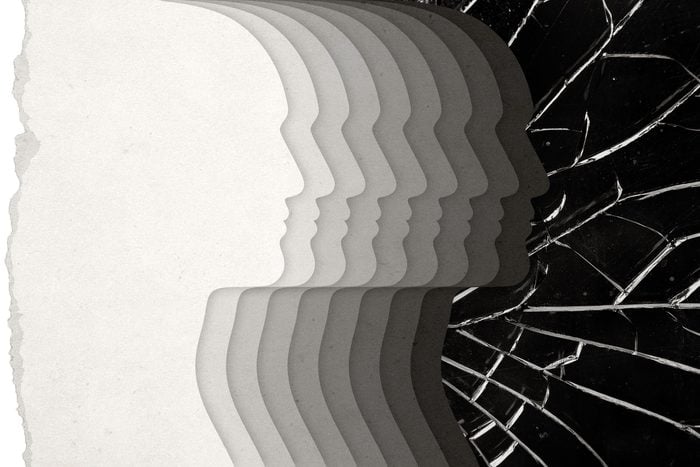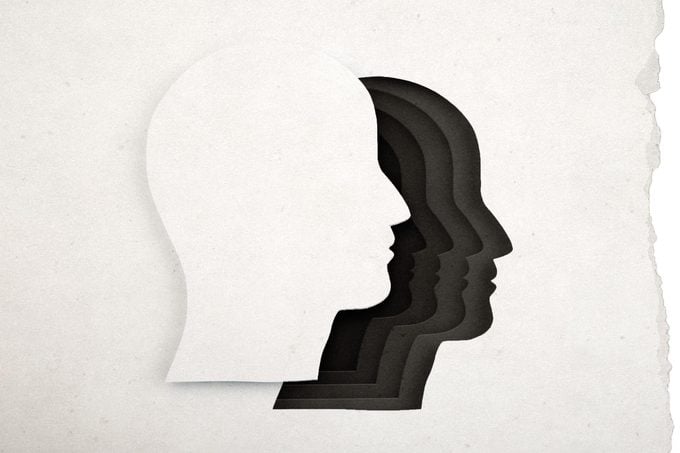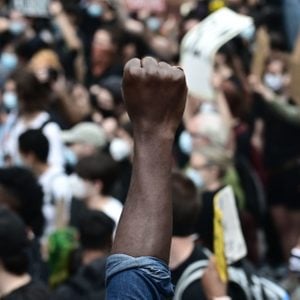What Is White Replacement Theory—and How Is It Fueling Racist Attacks?
Updated: Oct. 24, 2022

Another mass murder targeting minorities thrust "White Replacement Theory" into the American consciousness. Here, we explain this racist ideology—and why it's so dangerous.
The Reader’s Digest Version:
|
White Replacement Theory is a sociopolitical conspiracy theory with a body count. Nobody can say exactly how many people have died because of it in mass shootings and other forms of violence in America, but it’s not a small number.
That number increased by 10 on May 14, 2022, when a young White man, armed with a military-style weapon and dressed in body armor and a combat helmet, walked into a supermarket in Buffalo, New York. Police say the accused gunman, 18-year-old Payton Gendron, posted a 180-page screed online, detailing why he chose this particular store in a mostly Black neighborhood—he wanted to kill Black people to fight back against “the Great Replacement.” His weapon was also emblazoned with the insignia “14 words,” a shorthand for White supremacists whose message is at the core of this racist theory: “We must secure the existence of our people and a future for White children.”
For experts on the American White supremacist movement, this sent a stark message. “It conveys to me that what a few years ago we were politely calling the alt-right has permeated the culture and has expanded the reach of its symbols,” says Adele Stan, a journalist and longtime chronicler of right-wing extremism in American politics. “Whatever you want to call it, it has now permeated our culture at the cellular level, and we have to talk about it.”
The “it” Stan is referring to is White Replacement Theory, which has made its way from the fringes of American culture into mainstream discourse over the last few years. But what is this theory, exactly, how does it relate to racial inequality and systemic racism, and just how dangerous is it? We spoke to experts to answer those questions, as well as find out what society can do to counter this racist ideology.
What is White Replacement Theory?
White Replacement Theory, also called “the Great Replacement” and “White genocide,” is the idea that some “other” group is out to destroy White people and their way of life. Proponents believe that minority groups are replacing the White majority in the United States and that if they don’t stop the influx of immigrants and suppress the political power of minorities, White culture as we know it will cease to exist. In short, it’s meant to make White people afraid that they will soon lose their privileged place at the peak of society because Black and Brown people, immigrants and U.S.-born alike, will “submerge” them. Other defining characteristics of this belief? That it is an orchestrated plot, and one that Jewish people and liberals are encouraging to gain social and political advantage.
This theory has its foundation in the fact that homogeneous populations cannot exist undisturbed for long—that is, a “pure race” can only be maintained by rigid exclusion of any outsiders, which is ultimately impossible. Therefore, White Replacement Theory adherents argue, the “outsiders” must be subjugated, exiled, or eliminated.
Where does White Replacement Theory come from?
The term “the Great Replacement” comes from the title of a 2011 book by French author Renaud Camus, in which he argues that immigration is diluting French culture specifically, and European culture more generally. Dark-skinned Muslim immigrants from the Middle East were the ones in Camus’ crosshairs at the time. (The “14 words,” however, were coined by American domestic terrorist David Lane in the 1980s.)
But while the name of this theory might be a recent creation, the idea is a much older vintage—and not as “fringe” as you might think. “This is a rebranding of a very old idea in the United States,” says Cassie Miller, a senior research analyst at the Southern Poverty Law Center. “It’s a recent term for an old set of ideas that have motivated policy in the U.S. for a very long time.”
Experts point to the very beginnings of the United States, when European explorers and settlers overpowered the Native Americans. “When the American nation was created, it was formed around the question of who [was] culturally appropriate to be accepted as ‘American,'” says Lawrence Hashima, who teaches American Studies at California State University, Long Beach. “Starting right from the beginning, how do you justify taking Native American land? You cast them as a culturally incompatible population.”
Exclusion of the “other” was even written into the U.S. Constitution. In it, enslaved people were literally described as “other Persons” and counted as only three-fifths of a person. But there were plenty of other moments in this country’s history in which the White ruling class panicked in response to changes in immigration, western expansion, and economic uncertainty. That list includes the “nativist movement” in response to an influx of Catholic immigrants from Italy and Ireland in the 1840s, the Chinese Exclusion Act of 1882, the Immigrant Act of 1924 (which was influenced by an American eugenicist and author whose work was later embraced by Hitler), and the more recent anti-Muslim hate crimes after 9/11.
Why is White Replacement Theory so dangerous?
This theory maintains that White people are under attack and must do whatever it takes to fight for their survival. In the minds of adherents, it’s an actual war, and the “threats” are growing every day. “The urgency, the idea that the clock is ticking, allows them to go after anyone they see as their racial enemies,” says Miller. And that, of course, can lead to violence.
“Jews will not replace us” was the chilling chant at the “Unite the Right” march in Charlottesville, Virginia, on August 12, 2017. By the next morning, violence broke out between White supremacists and counter-demonstrators, and by the afternoon, 32-year-old Heather Heyer was dead, struck by a car driven deliberately into a crowd of peaceful protesters.
But what happened in Charlottesville was not an aberration—and violence connected to White Replacement Theory has become a shockingly common occurrence in the United States. Here are some recent notable examples, which are counted in America’s gun violence statistics but stand out for their motives:
- In 2015, Dylann Roof killed nine Black people who were attending a bible study class in Charleston, South Carolina. In his confession, he said the act was in response to what Black people are “doing to White people every day, all the time.” Roof became the first person in American history sentenced to death for a federal hate crime.
- In 2019, John Earnest pled guilty to murdering one person and attempted murder of 53 others in a synagogue in the San Diego suburb of Poway during Passover. In a disturbing manifesto, he wrote that he did so to prevent the “meticulously planned genocide of the European race.”
- Also in 2019, police say 21-year-old Patrick Crusius went into a Walmart in El Paso, Texas, armed with an assault rifle with the intent to kill “Mexicans.” An online diatribe believed to be written and posted by Crusius—who has still not stood trial for the crimes—cited “the Great Replacement” and “Hispanic Invasion” as the cause for the attack, which left 23 dead and 23 wounded.
White Replacement Theory around the world
In case you were wondering, this isn’t a uniquely American phenomenon. In Christchurch, New Zealand, a 2019 mosque massacre, where 51 were killed and 40 wounded, was perpetrated by a White supremacist who feared “White genocide.” And in Norway in 2011, Anders Behring Breivik killed 77 people in a bombing and mass shooting; many of the victims were children attending a summer camp sponsored by the country’s center-left Labor Party. Breivik blamed the Labor Party for “pandering to multiculturalism” and justified his crimes as a “preemptive war…before our major cities are completely demographically overwhelmed by Muslims.”
For some, violence is a means to a darker end. Self-described “accelerationists” seek to hasten the collapse of a democratic, multicultural society that threatens the supposed White race. Leaders of the Southern California White supremacist organization Rise Above Movement were arrested in 2018 and charged with deliberately instigating riots in liberal enclaves like Berkeley, California. One of those leaders, Robert Rundo, fled the United States, and as of April 2022, he was reportedly living in Bosnia-Herzegovina or Serbia, where he’s been engaging with far-right nationalist groups.
And in general, “the violence is a feature, not a bug,” says Stan. “It’s exciting. It makes young kids feel tough. It’s used for propaganda and recruitment.”
Who believes in this ideology?
While White supremacists typically believe in White Replacement Theory, not everyone who believes in this theory would describe themselves as a White supremacist. In fact, this seemingly fringe theory has gone mainstream over the past few years, with inflammatory rhetoric on talk radio and cable news shows being echoed by opportunistic politicians targeting a portion of the White population that feels disenfranchised and disempowered. “This is an idea that is really malleable,” says Miller. “Although it’s often used to target immigrants, it can be wielded to target many different groups of people, and many groups can be blamed for this supposed nefarious process.”
And the number of people who believe in the tenets of White Replacement Theory, even if they don’t use those exact words, is disturbingly high. A recent Associated Press poll—published, coincidentally, two days before the Buffalo massacre—found that around a third of Americans believe there is a deliberate plot underway to allow immigrants entry to the United States for political gain. And about 30 percent believe that increased immigration is causing native-born Americans to lose their economic, political, and cultural power. The difference between Democrats and Republicans on that latter question is surprisingly narrow, at 27 percent to 36 percent, respectively.
The poll also showed that 17 percent believe both in the deliberate effort to sway domestic politics through immigration and the loss of native-born influence as a result. Among those who embrace other conspiracy theories, a full 42 percent are in that camp. Stan sees the connection between conspiracy theories like Q-Anon and White Replacement Theory as a natural link. “In every one of these conspiratorial narratives, it’s all about pecking order in society,” she says. “Who are the elites who are controlling things, and [who is] not worthy? Whatever it is that the supposed elites are doing, it’s keeping ‘worthy’ people down. And losing one’s proper place in the societal pecking order is a huge blow.”

Who is popularizing White Replacement Theory?
Once the domain of overt racists who were generally avoided in polite society, White Replacement Theory is now openly discussed and embraced on social media, cable news, and more. And that’s an enormous problem. So, how did the field of acceptable dialogue shift so dramatically, so fast?
Social media
Social media is often blamed for the spread of hateful ideas. And while it’s true that many a racist idea or false or distorted “fact” finds its way onto our Facebook pages and Twitter feeds—not to mention what happens on sites like 4chan and 8chan—fault can’t be placed entirely in their laps.
“Social media companies all have terms of service with standards of behavior they define. There’s no legal obligation to enforce it, but there’s certainly an ethical one,” says Jeff Blevins, professor of journalism at the University of Cincinnati and author of the forthcoming book Social Media, Social Justice and the Political Economy of Online Networks. Over the past few years, Facebook and Twitter have made very public efforts to clean up their sites and kick out people who post false, bigoted, violent content, but Blevins says it’s too little too late. “That person they kick off the site pops up somewhere else, and that message has already been spread, retweeted, saved on a screenshot. The damage is already done.”
But blaming the platform providers is not entirely fair to them and is overly generous to ourselves, notes Stan. “There’s plenty of blame to be ascribed to social media companies,” she says, “but the leap to place responsibility on their doorstep lets too many people off the hook. We need to have a really deep cultural discussion about this and where we went wrong.”
Politicians
In 2019, former Iowa congressman Steve King was stripped of his committee assignments for publicly embracing White nationalism. In one of his tweets, he wrote, “Culture and demographics are our destiny. We can’t restore our civilization with somebody else’s babies.” Many considered that statement to be a thinly veiled reference to White Replacement Theory.
Just three years later, in 2022, representatives Marjorie Taylor Greene of Georgia and Paul Gosar of Arizona have faced no official consequences for speaking at a conference organized by a well-known White supremacist and sharing the stage with him as he praised Adolf Hitler and spewed White genocide dogma. Miller says that the line between acceptable and unacceptable political discourse has been creeping in the wrong direction for many years.
Perhaps even worse is the place where politics and social media meet. The media watchdog organization Media Matters for America recently found that Facebook has been profiting from political campaign ads using White Replacement Theory rhetoric, including claims that “migrants are invading the border.” The ads were placed by fringe organizations, mainstream political committees and PACs, and candidates for office ranging from local school boards to the United States Senate.
Media personalities
“Over past 10 years or so, the idea [of White Replacement Theory] has been making its way to more mainstream circles to the point where it’s regularly featured on the most-watched cable news program in the country,” Miller says. Indeed, Fox News host Tucker Carlson has become a lightning rod for criticism in bringing White Replacement Theory into the living rooms of Middle America. The New York Times recently published a report showing more than 400 instances since 2016 of Carlson repeating and promoting “the Great Replacement” to his audience, which reaches nearly 3.5 million viewers a night. And sadly, Carlson is not the only on-air purveyor of this inflammatory discourse.
Another issue is that more mainstream outlets have dropped the proverbial ball, says Stan. “There is a problem in the structure of journalism at the moment that gives these extreme viewpoints space to fester—there is certainly a tolerance for certain extreme rhetoric,” Stan continues. “As this tolerance has grown in the political class, there’s a field of journalism that doesn’t know how to cope with it. They don’t understand it, they don’t know the code [the extremists use]. The evidence has been bubbling up, but the people who needed to be paying attention haven’t been doing it.” By not treating the threat as real and growing, traditional news outlets allowed it to fester.
More Stories About Racism in America
|
What can be done to counter White Replacement Theory?
This conspiracy theory attacks the heart of America’s melting pot ethos, and it shouldn’t be left unchecked. While those spreading this dangerous dogma have a First Amendment right to speak, the rest of us have the right to stand up to them and oppose these ideas. Here are a few ways to do that.
Recognize the warning signs
In many of the attacks inspired by White Replacement Theory, perpetrators exhibited clear warning signs that were ignored, or where action wasn’t taken despite alarms being raised. Classmates of the California synagogue shooter, for example, told college officials about his fixation on Hitler and White-supremacist murderers, but because he hadn’t made any specific threats, police were barred from doing anything. The mother of Heather Heyer’s murderer told reporters she was not aware of her son’s extremist views; his teachers, however, said he professed admiration for Hitler and racist doctrine as a high schooler. And investigators are currently trying to determine whether a mental health assessment following threats to shoot up a high school could have triggered New York’s “red flag” law and kept guns out of the Buffalo shooter’s hands.
But those efforts address the symptom rather than the disease. “The alarm bells keep being rung,” says Patrice O’Neill, a documentary producer and the CEO of Not in Our Town. “There’s a price to pay for hate, and we’re going to find out what that price is if we don’t do something.”
Educate yourself and find common ground
O’Neill’s production company covers community responses to race-based violence with thought-provoking documentaries. Its most recent production, “Repairing the World,” tells the story of the aftermath of the deadly 2018 shooting at the Tree of Life synagogue in Pittsburgh, the deadliest anti-Semitic attack in American history. The film premiered on May 5, just nine days before the Buffalo massacre. It details how the accused killer became radicalized by listening to talk radio and joining social media frequented by alt-right activists spouting racist rhetoric, including White Replacement Theory.
She says that documentaries like hers can help highlight the strength of communities coming together, despite differences, to push back against those seeking to terrorize minorities. “They’re pulling people into the core value of resisting racism, turning away from anti-Semitism, and finding common humanity,” she says. “Finding this connection, knowing we have to stand up for each other or we could be next, is something that comes through very clearly. Parents are deeply concerned about how their children are being influenced by the toxic nature of the discourse and the hate messages. Tapping into that core message of fairness and inclusion—that’s something everybody can agree on.”
Engage in community discussion
With every film O’Neill produces, she attends a community screening in the city where it was filmed. It’s part of what she calls a “restorative narrative,” where the community helps heal itself through talking, listening, and understanding. “There needs to be opportunity and context for gathering in a safe environment and letting a majority of people express themselves in rejection of racism,” she says, “because it is a majority of us who reject racism.”
While this is a very specific sort of community discussion, you can find others in your town. Seek out groups where people can come together, talk about the problems facing your community or the larger world, and attempt to find action-based solutions to combat racism.
Hold others accountable
Media critic Dan Froomkin says there can be no more coddling of those who traffic in White Replacement Theory messaging. “It really shouldn’t be hard for most people to agree that talking about white replacement is harmful and racist,” he writes for PressWatch. “It should be easy to say: I don’t believe that.” Those who can’t or won’t say so, or who make excuses, dodge, and deflect, are presumptively racist and should be treated as such, he adds.
While Froomkin was talking specifically about those in politics and the media, and the fact that we should be careful of the media we consume, that sentiment should carry over into our daily lives as well. If someone is spouting racist rhetoric, even if it’s subtle, say something. Remember: Subtle references to racism are still racism, and if we’re being truly honest with ourselves, none of it is actually subtle.
But the true key to countering this problem, suggests Stan, is connecting with one another and bridging the gap. That effort, she adds, needs to start one on one, neighbor to neighbor, and, to the extent that our COVID-era lives permit, face to face. “We really need to connect more deeply in the physical spaces where we live and with the people we live there with. It’s going to be a long road, but we need to take that walk,” she says. “I know this sounds Pollyannaish, but we’re not going to get anywhere until we can speak in a community of people from a variety of experiences and decide that living in this kind of fear of each other is not freedom. We need to find strength in each other.”
Sources:
- Adele Stan, a journalist and longtime chronicler of right-wing extremism in American politics
- Cassie Miller, a senior research analyst at the Southern Poverty Law Center
- Lawrence Hashima, professor of American Studies at California State University, Long Beach
- The Atlantic: “White Nationalism’s Deep American Roots”
- ADL.org: “‘The Great Replacement:’ An Explainer”
- Vox: “Accelerationism: the obscure idea inspiring white supremacist killers around the world”
- Newsweek: “‘Great Replacement Theory’ Has Inspired 4 Mass Shootings in Recent Years”
- ISD Global: “‘The Great Replacement:’ The Violent Consequences of Mainstreamed Extremism”
- AP/NORC: “Immigration Attitudes and Conspiratorial Thinkers: A Study Issued on the 10th Anniversary of The Associated Press-NORC Center for Public Affairs Research”
- Jeff Blevins, professor of journalism at the University of Cincinnati and author of the forthcoming book Social Media, Social Justice and the Political Economy of Online Networks
- Media Matters for America: “Facebook profited from ads promoting white supremacist ‘great replacement’ theory”
- The New York Times: “Tucker Carlson”
- Patrice O’Neill, a documentary producer and the CEO of Not in Our Town
- PressWatch: “Replacement rhetoric is the litmus test the media has been waiting for”



